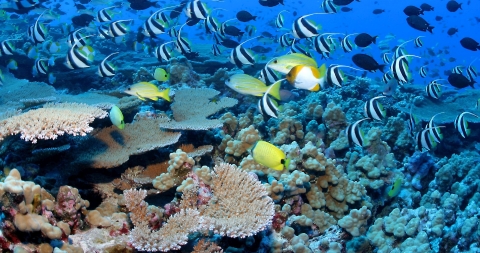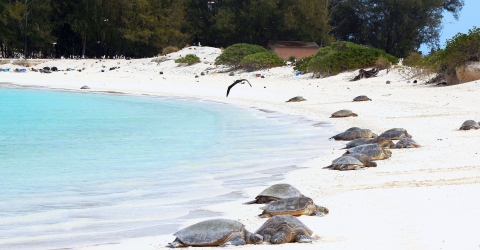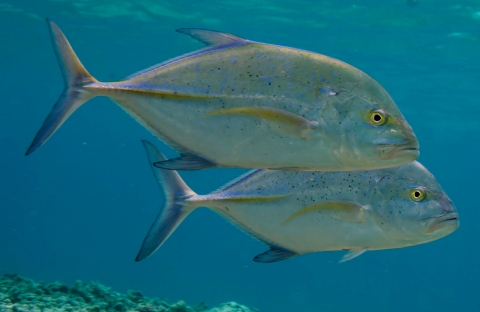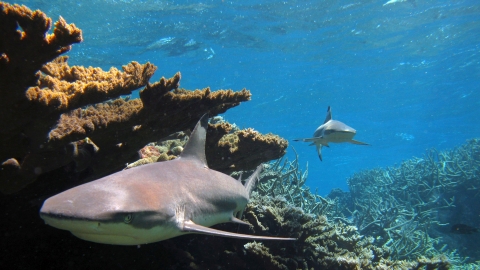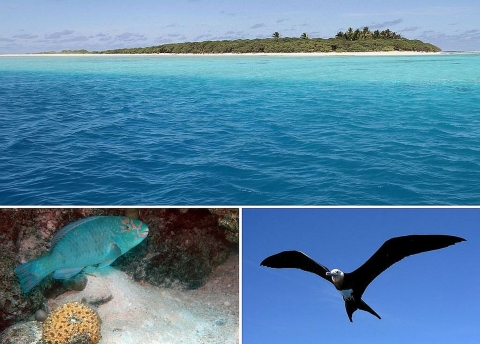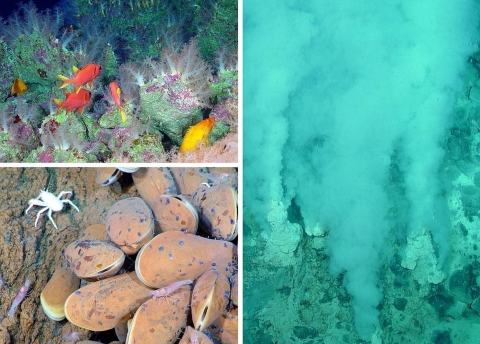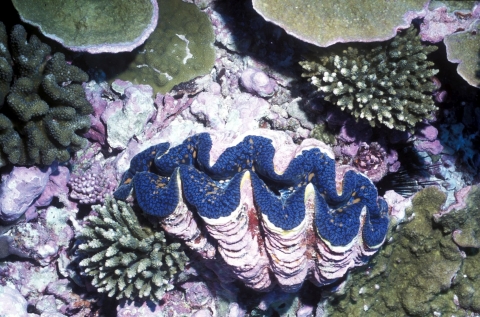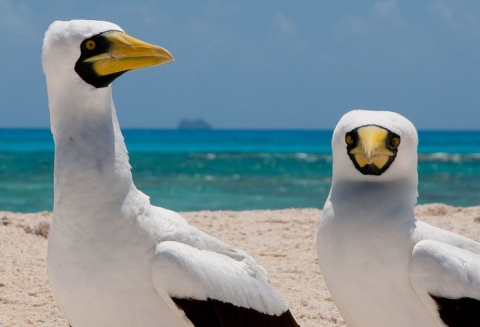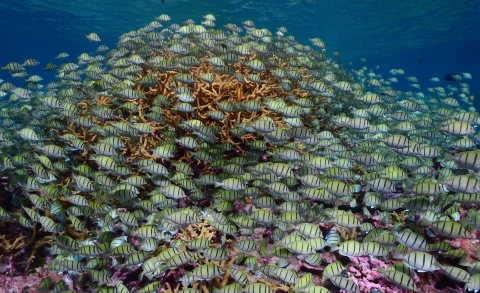Oceanographer and explorer Sylvia Earle has said, “Health to the ocean means health for us.”
The ocean covers almost three-quarters of Earth’s surface and contains about 97 percent of the planet’s water. The ocean is home to an almost otherworldly array of rainbow-colored fish, exotic plants, large-winged seabirds, powerful marine mammals, living corals and vital microorganisms. We are just beginning to understand how those ocean creatures are interconnected with one another and with us.
The U.S. Fish and Wildlife Service is partnering with the National Oceanic and Atmospheric Administration, state and territorial governments and others to conserve the ocean and remote islands and atolls in it. The two federal agencies cooperatively manage five marine national monuments.
Earle has called the marine national monuments “hope spots” for ocean health.
For the most part, the marine national monuments are managed within the National Wildlife Refuge System, which is better known for conserving land.
“We, as humankind, understand the importance of terrestrial conservation,” says Matt Brown, a former Fish and Wildlife Service superintendent for the Pacific marine national monuments. “As humans, we have set aside over 15 percent of land for conservation. That’s not just our nation; that’s nations around the globe. We’re now somewhere between 3 and 4 percent for the ocean.”
In terms of its needs, the ocean ecosystem isn’t much different from the terrestrial ecosystem, Brown says. “Wild animals need wild spaces. And the marine national monuments are the cornerstone of that.”
Humans are putting huge pressure on the ocean ecosystem. Humans are polluting ocean waters with contaminants, runoff and garbage, especially plastics. Humans are overfishing in some places, often indirectly killing other marine species in the process. Furthermore, a changing climate is raising water temperature, altering weather patterns and accelerating ocean acidification – all of which disrupt the ocean ecosystem.
"What the marine national monuments do,” says Brown, “is give ocean wildlife a chance to survive – just as terrestrial refuges and parks do – by giving a reprieve from human pressures.”
This is especially important, Brown says, because “oceans sustain human life on Earth. Fifty percent of the oxygen we breathe comes from the oceans. People also gain recreational, spiritual and philosophical benefits from the ocean. People gain economic benefit from the ocean. Three billion people rely primarily on the ocean for their food, their livelihood and their survival.”
Four marine national monuments stretch across much of the Pacific Ocean.
In fact, each day the sun first rises over those monuments and last sets on them, too.
The first refuge to see dawn is Wake Atoll National Wildlife Refuge, part of Pacific Remote Islands Marine National Monument.
The last to see dusk is Midway Atoll National Wildlife Refuge, part of Papahānaumokuākea Marine National Monument.
One marine national monument is in the Atlantic Ocean.
Papahānaumokuākea, at more than 580,000 square miles, is the largest marine national monument. “It’s the largest protected area under U.S. jurisdiction. It’s the largest wholly protected area on Earth,” says Brown. “At its heart is the most remote island chain in the world, the Hawaiian Archipelago.”
The deep water at the far end of Papahānaumokuākea is home to scores of species found nowhere else on Earth.
Additionally, Papahānaumokuākea “is the spiritual birthplace and the spiritual home of the Hawaiian people, and so it is a place of enormous cultural significance,” says Brown. “It’s also a place of enormous historical significance. The Battle of Midway was the turning point of World War II. It’s all of these layers that make Papahānaumokuākea so special.”
If you’re wondering how to pronounce Papahānaumokuākea, here’s how. If you’re wondering what it means in Hawaiian, here’s the answer.
Pacific Remote Island Marine National Monument includes seven national wildlife refuges. “These far-flung, isolated spots in the ocean are actually the most diverse of the marine national monuments. Thousands upon thousands of species make up these unique places from Jarvis Island to Wake Atoll to Johnston Atoll to Howland Island to Baker Island to Kingman Reef to Palmyra Atoll. These are the most isolated and as close to pristine ecosystems as we have under U.S. jurisdiction. These are simply the best of the best,” says Brown. “The fact that they’re remote makes them difficult to understand, but the fact that they’re remote makes them each unique. They are these incredible hot spots for biodiversity and the health of the planet and our ocean.”
Palmyra Atoll National Wildlife Refuge, for instance, is 25 islets encircling three lagoons surrounded by a 16,000-acre coral reef ecosystem. Its location, rich biological systems and lack of persistent human pressures make it a singular setting for globally important research.
Rose Atoll is the smallest of the Pacific marine national monuments, at a little more than 10,000 square miles. Situated in American Samoa, 872 miles south of the equator, Rose Atoll also is the southernmost point under U.S. jurisdiction.
“What’s so cool about Rose Atoll is that this relatively small, little speck in the middle of the south Pacific, has this … global impact,” says Brown. It’s a safe haven for millions of seabirds, including some displaced by environmental disruptions such as El Nino weather patterns. Sea turtles that nest at Rose Atoll eventually spread across the south Pacific to Fiji and New Caledonia and Samoa and the Cook Islands.
Marianas Trench Marine National Monument is about 36,000 feet deep and covers 95,216 square miles of ocean off the coast of the Commonwealth of the Northern Mariana Islands.
“The trench has changed our understanding of life on this planet,” says Brown. “The trench, the undersea volcanoes – these spots – have altered our understanding of life. There was a time years ago when we believed organisms needed sunlight to survive, and that’s wildly untrue. We have fish that live on pools of liquid sulfur. We have these methane gas vents that have little shrimp inside them. There are just these creatures and environments that defy the imagination. And every time we’ve looked at these places, these new undersea mud volcanoes and the deepest spot in the ocean, we learn more about the world we live in … You couldn’t dream up the things that they see down there.”
Check out this video from Champagne Vent at Marianas Trench.
Northeast Canyons and Seamounts Marine National Monument was established in 2016 in the Atlantic Ocean off New England. Its waters are home to numerous species of deep-sea corals, fish, whales and other marine mammals. Three submarine canyons and, beyond them, four undersea mountains lie in the waters approximately 130 miles southeast of Cape Cod.
So, what can a mainlander who lives in, say, Kansas City, do to help conserve the ocean?
“If that person in Kansas City is conscientious enough to work on prairie restoration, if they are conscious of making sure that their food is as sustainable as can be, that they are buying seafood that’s not on the seafood watch list, if they are recycling, if they are minimizing their energy footprint, if they are conserving water, all of those things add up,” says Brown. “If we all conserve the best we can for a healthier terrestrial ecosystem, that makes for a healthier ocean.”
Mainlanders also can get involved with Friends organizations or nonprofits that support the marine national monuments. Here are a few possibilities:
- Friends of Midway Atoll National Wildlife Refuge
- Friends of Hawaiian Islands National Wildlife Refuge (Facebook page)
- Opportunities at Papahānaumokuākea Marine National Monument
- Island Conservation
- National Wildlife Refuge Association
“As a country and as an agency, we have spent the past 100-plus years perfecting the conservation tools on land that are necessary to protecting these places in the ocean,” says Brown. “It takes effort, and it’s challenging, but because of the work of our agency, because of the work of the American people, we are positioned to be leaders in marine conservation. And with 70-plus percent of the world being ocean, that is where we need to be.”


